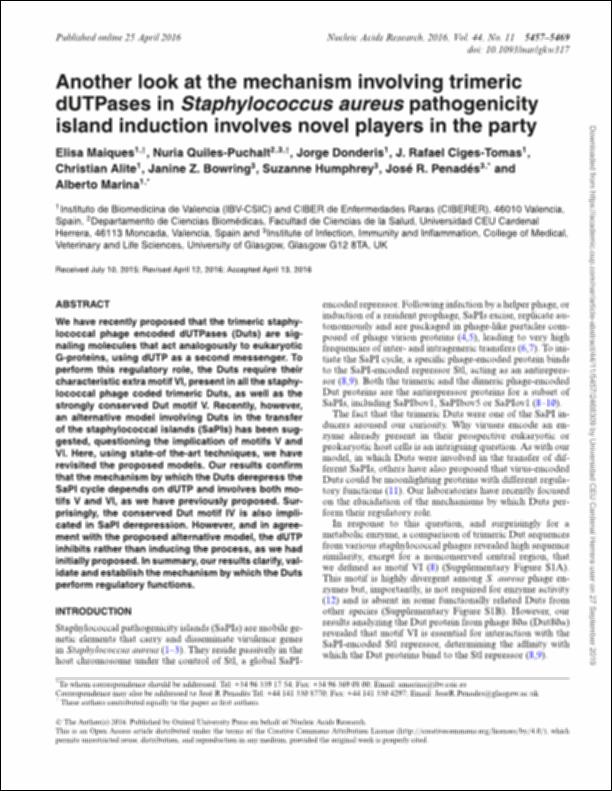Please use this identifier to cite or link to this item:
http://hdl.handle.net/10637/10627Another look at the mechanism involving trimeric dUTPases in Staphylococcus aureus pathogenicity island induction involves novel players in the party
| Title: | Another look at the mechanism involving trimeric dUTPases in Staphylococcus aureus pathogenicity island induction involves novel players in the party |
| Authors : | Maiques Fernández, Elisa Quiles Puchalt, Nuria Donderis, Jorge Ciges Tomás, J. Rafael Alite, Christian Bowring, Janine Humphrey, Suzanne Penadés Casanova, José Rafael Marina, Alberto |
| Keywords: | Estafilococos.; Staphylococcus.; Bacteriología médica.; Pathogenic bacteria.; Medical bacteriology.; Medical microbiology.; Bacterias patógenas.; Microbiología médica. |
| Publisher: | Oxford University Press. |
| Citation: | Maiques, E., Quiles-Puchalt, N., Donderis, J., Ciges-Tomas, JR., Alite, C., Bowring, JZ. et al. (2016). Another look at the mechanism involving trimeric dUTPases in Staphylococcus aureus pathogenicity island induction involves novel players in the party. Nucleic Acids Research, vol. 44, n. 11 (jun. 2016), pp. 5457-5469. DOI: https://doi.org/10.1093/nar/gkw317 |
| Abstract: | We have recently proposed that the trimeric staphylococcal phage encoded dUTPases (Duts) are signaling molecules that act analogously to eukaryotic G-proteins, using dUTP as a second messenger. To perform this regulatory role, the Duts require their characteristic extra motif VI, present in all the staphylococcal phage coded trimeric Duts, as well as the strongly conserved Dut motif V. Recently, however, an alternative model involving Duts in the transfer of the staphylococcal islands (SaPIs) has been suggested, questioning the implication of motifs V and VI. Here, using state-of the-art techniques, we have revisited the proposed models. Our results confirm that the mechanism by which the Duts derepress the SaPI cycle depends on dUTP and involves both motifs V and VI, as we have previously proposed. Surprisingly, the conserved Dut motif IV is also implicated in SaPI derepression. However, and in agreement with the proposed alternative model, the dUTP inhibits rather than inducing the process, as we had initially proposed. In summary, our results clarify, validate and establish the mechanism by which the Duts perform regulatory functions. |
| Description: | Este artículo se encuentra disponible en la siguiente URL: https://academic.oup.com/nar/article/44/11/5457/2468309 |
| URI: | http://hdl.handle.net/10637/10627 |
| Rights : | http://creativecommons.org/licenses/by/4.0/deed.es |
| ISSN: | 0305-1048 1362-4962 (Electrónico) |
| Issue Date: | 2-Jun-2016 |
| Center : | Universidad Cardenal Herrera-CEU |
| Appears in Collections: | Dpto. Ciencias Biomédicas |
Items in DSpace are protected by copyright, with all rights reserved, unless otherwise indicated.


